当前位置:
X-MOL 学术
›
Soft Matter
›
论文详情
Our official English website, www.x-mol.net, welcomes your
feedback! (Note: you will need to create a separate account there.)
Leidenfrost phenomenon during quenching in aqueous solutions: effect of evaporation-induced concentration gradients.
Soft Matter ( IF 2.9 ) Pub Date : 2020-06-05 , DOI: 10.1039/d0sm00622j Vijay Kumar 1 , Kumar Nishant Ranjan Sinha 1 , Rishi Raj 1
Soft Matter ( IF 2.9 ) Pub Date : 2020-06-05 , DOI: 10.1039/d0sm00622j Vijay Kumar 1 , Kumar Nishant Ranjan Sinha 1 , Rishi Raj 1
Affiliation

|
The minimum temperature limit for a sustained vapor film on a hot surface defines the well-known Leidenfrost temperature (LFT). LFT for pure fluids is typically a strong function of the surface tension. However, the effect of surface tension on LFT of aqueous additive solutions is confusing with many complicated trends. For example, despite an insignificant increase of ≈1 mN m−1 in surface tension, a substantial increase in LFT of ≈50 °C with aqueous salt and sugar solutions has been reported in comparison to pure water. Conversely, no appreciable change in LFT (within ±2 °C) is observed despite a substantial drop of up to ≈30 mN m−1 in surface tension upon varying the concentration of surfactant additives in aqueous solutions. Here, we perform simultaneous thermal, visual, and acoustic characterization of pool quenching experiments with aqueous solutions of salt, sugar, surfactant, and ionic liquids. We model the evaporation-induced increase in the concentration of the non-volatile additives at the liquid–vapor interface using Fick's second law of diffusion. We show that the localized concentration buildup of additives at the liquid–vapor interface dramatically alters the surface tension values in comparison to the typical equilibrium values estimated otherwise. We use these modified surface tension values to correlate the diverse set of experimental LFT data reported in our work and in the literature using a unified framework. We believe that these clarifications regarding the Leidenfrost mechanism will encourage the use of additives in various applications, specifically those where surface modification strategies may not be practically feasible.
中文翻译:

水溶液淬火过程中的莱顿弗罗斯特现象:蒸发引起的浓度梯度的影响。
在热表面上形成连续蒸汽膜的最低温度限制定义了众所周知的莱顿弗罗斯特温度(LFT)。纯流体的LFT通常是表面张力的重要函数。然而,表面张力对水性添加剂溶液的LFT的影响使许多复杂的趋势变得混乱。例如,尽管表面张力增加了约1 mN m -1,但与纯水相比,盐和糖水溶液的LFT显着增加了约50°C。相反,尽管出现了高达≈30mN m -1的大幅下降,但未观察到LFT的明显变化(在±2°C内)。通过改变水溶液中表面活性剂添加剂的浓度来改变表面张力。在这里,我们使用盐,糖,表面活性剂和离子液体的水溶液同时进行池淬火实验的热,视觉和声学表征。我们使用菲克第二扩散定律模拟蒸发诱导的非挥发性添加剂在液-气界面浓度的增加。我们表明,与其他方法估算的典型平衡值相比,添加剂在液-气界面处的局部浓度累积会极大地改变表面张力值。我们使用这些修改后的表面张力值,使用统一的框架将在我们的工作和文献中报告的各种实验LFT数据关联起来。
更新日期:2020-07-08
中文翻译:

水溶液淬火过程中的莱顿弗罗斯特现象:蒸发引起的浓度梯度的影响。
在热表面上形成连续蒸汽膜的最低温度限制定义了众所周知的莱顿弗罗斯特温度(LFT)。纯流体的LFT通常是表面张力的重要函数。然而,表面张力对水性添加剂溶液的LFT的影响使许多复杂的趋势变得混乱。例如,尽管表面张力增加了约1 mN m -1,但与纯水相比,盐和糖水溶液的LFT显着增加了约50°C。相反,尽管出现了高达≈30mN m -1的大幅下降,但未观察到LFT的明显变化(在±2°C内)。通过改变水溶液中表面活性剂添加剂的浓度来改变表面张力。在这里,我们使用盐,糖,表面活性剂和离子液体的水溶液同时进行池淬火实验的热,视觉和声学表征。我们使用菲克第二扩散定律模拟蒸发诱导的非挥发性添加剂在液-气界面浓度的增加。我们表明,与其他方法估算的典型平衡值相比,添加剂在液-气界面处的局部浓度累积会极大地改变表面张力值。我们使用这些修改后的表面张力值,使用统一的框架将在我们的工作和文献中报告的各种实验LFT数据关联起来。











































 京公网安备 11010802027423号
京公网安备 11010802027423号